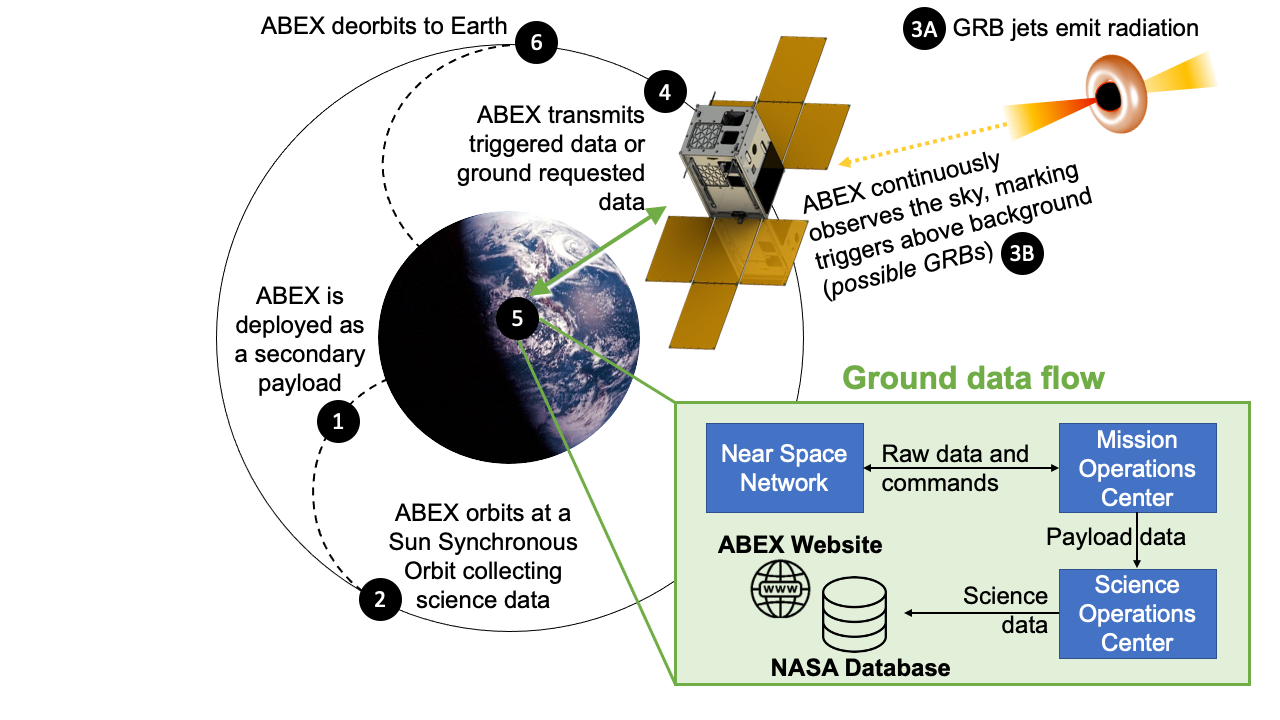The Mission
The Alabama Burst Energetics eXplorer (ABEX) is an astrophysics and educational mission to engage students and faculty across the state of Alabama in aerospace engineering. The mission is a partnership between seven academic institutions, the University of Alabama, University of South Alabama, Auburn University, University of Alabama in Huntsville, University of Alabama in Birmingham, Alabama A&M University, and Drake State Community and Technical College. The science of ABEX is to study the mechanisms in gamma-ray bursts focusing on the unobserved low-energy component in their prompt emission. The science is accomplished using a novel instrument suite of X-ray and gamma-ray detectors onboard a compact 12U CubeSat. As part of its educational mission, ABEX involves students in all aspects of its design and management, with the payload and spacecraft subsystems designed directly by students in undergraduate and graduate programs.
-
1
ABEX is deployed as a secondary payload or rideshare, meaning a launch vehicle ascends to the desired orbital location and ejects ABEX from its dispenser. ABEX features mechanisms to detect ejection allowing it to begin early operations such as detumbling and solar array deployment.
-
2
ABEX orbits Earth in a Sun-Synchronous orbit and establishes its ability to collect science data. It will take a few conversations between ABEX and the Near Space Network (NSN) to determine the appropriate calibration metrics for the ABEX X-ray and Gamma-ray detectors.
-
3A
A Gamma-ray Burst (GRB) occurs and emits highly energetic radiation. This is one of the most energetic events in the universe, and ABEX is helping humanity understand the composition and dissipation mechanisms of the GRB.
-
3B
At the same time, ABEX is listening for GRBs by detecting energy signatures above a calibrated threshold. If a non-GRB energy event occurs and is detected, ABEX's science payload would filter that out. If a GRB occurs and is detected, ABEX timestamps that data, distinguishes it from the background noise, and sends the data to the On-Board Computer in preparation for Earth downlink.
-
4
Every ~12 hours, ABEX communicates a 50 MB message to the NSN and listens for any commands the Mission Operations Center (MOC) may have uplinked to ABEX via the NSN. The 50 MB message contains science data, health diagnostics, event logs, and any information requested during the last communication window's uplink.
-
5
When the NSN receives the downlinked data, the NSN provides the raw data to the MOC at the University of Alabama in Huntsville (UAH) which parses the data and provides it to the Science Operations Center. Both the National Space Science and Technology Center and the Center for Plasma and Aeronomic Research are at UAH, so data availability for processing is immediate. When the data is ready for public release, it is released here under Published Data (coming soon).
-
6
At the end of the mission, ABEX will passively deorbit and burn up in Earth's atmosphere. Passive deorbit is expected to take much less than 25 years.

The ABEX Mission has four Phases: (1) Launch & Early Operations (LEOP), (2) Science Commissioning, (3) Science Operations, (4) Spacecraft Decommissioning.
-
1
LEOP: The spacecraft is launched, ejected, and powered on for the first time in space. After charging its batteries, ABEX communicates with Earth for the first time, reporting the status of its deployment procedures. The spacecraft will cycle between a sun-pointing Idle mode and Earth-pointing Communications modes with Safety and Reaction Wheel Desaturation modes occurring as needed until the MOC commands the spacecraft to proceed to Phase 2: Science Commissioning.
-
2
Science Commissioning: The MOC needs to know what the background radiation environment looks like through the X-ray and Gamma-ray detectors so the spacecraft can distinguish between background radiation and GRBs. The Spacecraft will take measurements of the background radiation environment at various orbital locations and communicate those to the MOC; the South Atlantic Anomaly and Van Allen Belts' High-Latitude Zones are radiation-intense areas that will affect the spacecraft's ability to distinguish between background radiation and GRBs. After a few weeks of cycling between Science mode and Communications mode with Safety and Reaction Wheel Desaturation modes occurring as needed, ABEX should be ready to detect the energy signature of GRBs.
-
3
Science Operations: Software modes for Phase 2: Science Commissioning are the same as Phase 3: Science Operations, only the instruments are more careful about which data sets are downlinked. ABEX will stay in Phase 3: Science Operations until the mission is deemed complete.
-
4
Spacecraft Decommissioning: After uplinking a final command to power down the spacecraft, the Mission Operations Center will play Closing Time by Semisonic loudly through the facility speaker system.